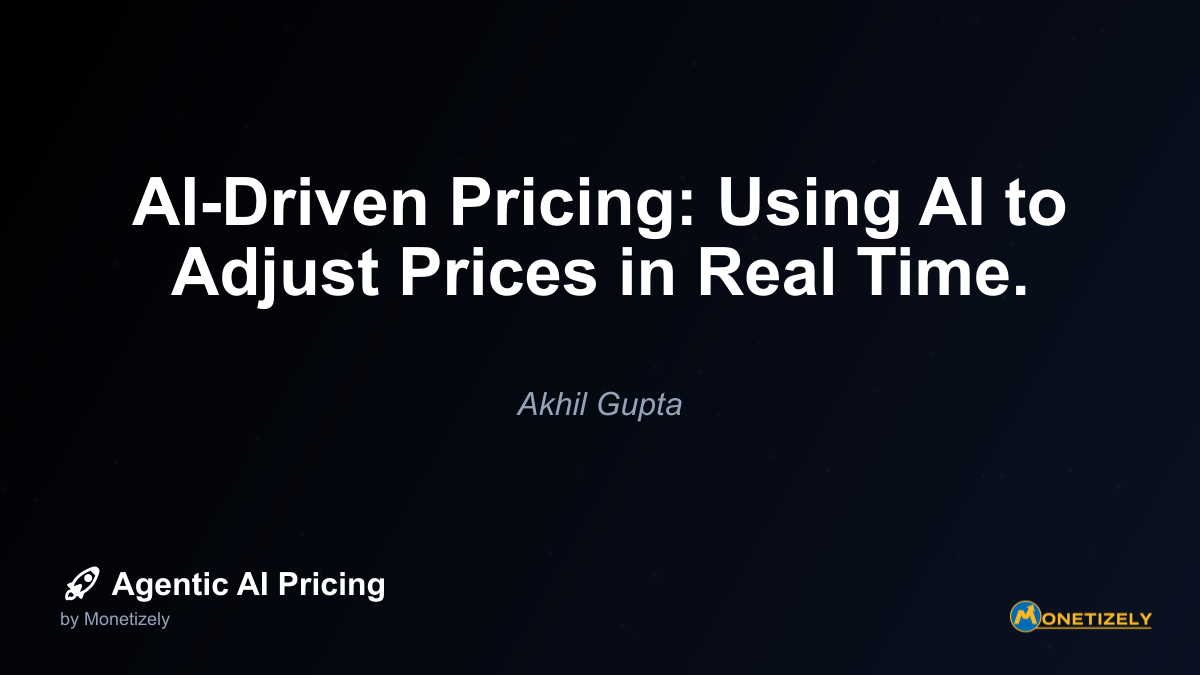· Akhil Gupta · Emerging Trends · 9 min read
Regulatory Impact: How New Laws Could Affect AI Pricing.
AI and SaaS Pricing Masterclass
Learn the art of strategic pricing directly from industry experts. Our comprehensive course provides frameworks and methodologies for optimizing your pricing strategy in the evolving AI landscape. Earn a professional certification that can be imported directly to your LinkedIn profile.

Regulations and compliance requirements continue to evolve rapidly in the artificial intelligence landscape, creating both challenges and opportunities for businesses implementing AI solutions. As governments worldwide grapple with the implications of increasingly capable AI systems, new regulatory frameworks are emerging that will fundamentally impact how AI products and services are priced, marketed, and deployed.
The Evolving Regulatory Landscape for AI
The regulatory environment for artificial intelligence is undergoing significant transformation. From the EU’s comprehensive AI Act to sector-specific regulations in healthcare, finance, and critical infrastructure, organizations face a complex patchwork of requirements that directly influence their AI pricing strategies.
Key Regulatory Frameworks Shaping AI Pricing
Several major regulatory initiatives are particularly relevant to AI pricing models:
The EU AI Act: This landmark legislation categorizes AI systems based on risk levels, imposing different compliance requirements for each tier. High-risk AI applications face stringent oversight, documentation requirements, and mandatory risk assessments.
US State-Level Regulations: States like California, Colorado, and Virginia have enacted comprehensive data privacy laws with specific AI provisions, creating a fragmented compliance landscape within the US market.
Sector-Specific Regulations: Financial services (FINRA, SEC), healthcare (FDA, HIPAA), and government procurement all have specialized AI requirements that affect pricing structures.
International Standards: Organizations like ISO and IEEE are developing AI-specific standards that, while voluntary, may become de facto requirements for competitive positioning.
These frameworks create a complex matrix of compliance requirements that inevitably impact how AI systems are priced and sold.
Direct Pricing Impacts of AI Regulations
Regulatory changes directly affect pricing strategies in several key ways:
Transparency Requirements and Unit Economics
New regulations increasingly mandate transparency in AI system operation, requiring clear disclosure of how AI makes decisions, what data it uses, and how it’s being billed. This has direct pricing implications:
Itemized Billing Requirements: Some jurisdictions are beginning to require detailed breakdown of AI usage costs, limiting the ability to use opaque bundled pricing.
Explainability Costs: The requirement to provide human-understandable explanations for AI decisions adds development costs that must be factored into pricing models.
Audit Trails: Maintaining comprehensive records of AI decision processes for regulatory review creates ongoing operational costs that affect unit economics.
For example, financial services firms using AI for credit decisions may need to provide detailed explanations of how the AI reached specific conclusions, requiring additional development work and customer support resources that impact pricing structures.
Compliance Costs and Pricing Floor Elevation
Regulatory compliance introduces substantial costs that establish effective price floors for AI products:
Documentation Requirements: Creating and maintaining comprehensive technical documentation adds fixed costs to AI development.
Risk Assessment Procedures: Regular algorithmic impact assessments and bias audits require specialized expertise and ongoing investment.
Training and Certification: Staff certification requirements add personnel costs that must be amortized across the customer base.
These compliance costs can be particularly challenging for smaller AI vendors, potentially leading to market consolidation as only larger players can afford comprehensive compliance programs.
How Data Privacy Regulations Reshape AI Pricing Models
Data privacy regulations like GDPR, CCPA, and their global counterparts have profound effects on AI pricing structures:
Data Usage Restrictions and Value-Based Pricing
Privacy regulations limit how customer data can be used, affecting value-based pricing approaches:
Cross-Customer Learning Limitations: Restrictions on using one customer’s data to improve services for others can reduce the network effects that justify premium pricing.
Data Portability Requirements: Mandatory data portability makes it easier for customers to switch vendors, potentially putting downward pressure on recurring subscription fees.
Consent Management Overhead: The need to obtain and manage specific consent for AI data processing adds administrative overhead that must be factored into pricing.
Data Localization Requirements and Regional Pricing
Many jurisdictions now require data to be stored and processed locally, creating regional cost variations:
Infrastructure Duplication: Companies may need to maintain separate AI infrastructure in different regions, leading to higher costs in markets with strict localization requirements.
Regional Price Differentiation: Different compliance burdens across markets may necessitate region-specific pricing strategies rather than global standardization.
Data Transfer Premium Charges: Some vendors now charge premium fees for compliant cross-border data transfers, creating tiered pricing based on geographic usage patterns.
For example, an AI vendor might need to charge higher prices in regions requiring local data processing infrastructure, or create region-specific pricing tiers based on local regulatory requirements.
AI Transparency Regulations and Their Pricing Implications
Emerging transparency regulations require AI systems to be explainable, fair, and accountable - all factors that influence pricing strategies:
Algorithmic Impact Assessments and Tiered Pricing
Requirements for formal algorithmic impact assessments create natural price differentiation opportunities:
Risk-Based Pricing Tiers: Higher-risk AI applications requiring more extensive impact assessments command premium pricing to cover compliance costs.
Certification Premiums: AI systems with formal certification of fairness or safety can justify premium pricing positions.
Compliance Documentation as Value-Add: Comprehensive compliance documentation becomes a competitive differentiator that supports premium pricing.
Explainability Requirements and Service Bundling
The need to make AI systems explainable creates opportunities for service bundling:
Explainability Tools as Upsell: Tools that provide transparency into AI decision-making become premium add-ons.
Human-in-the-Loop Services: Human review and explanation services emerge as high-margin complements to core AI offerings.
Compliance Consulting: Advisory services around regulatory compliance become valuable extensions to the core AI product.
For instance, healthcare AI vendors increasingly bundle explanation tools with their core diagnostic algorithms, creating natural upsell opportunities while satisfying regulatory requirements.
Sector-Specific Regulations and Vertical Pricing Strategies
Different industries face varying regulatory requirements for AI, necessitating sector-specific pricing strategies:
Healthcare AI Pricing Under Regulatory Constraints
Healthcare AI faces particularly stringent oversight:
FDA Approval Premiums: AI systems with formal FDA approval command significant price premiums that reflect the substantial investment required for regulatory clearance.
Reimbursement-Aligned Pricing: AI pricing increasingly aligns with healthcare reimbursement structures, with pricing justified by documented clinical and economic benefits.
Risk-Sharing Models: Regulatory uncertainty drives adoption of outcome-based pricing models that share risk between vendor and healthcare provider.
Financial Services AI and Compliance-Driven Pricing
Financial regulations create unique pricing considerations:
Audit-Ready Premium Tiers: Financial institutions pay premiums for AI systems designed for seamless regulatory audits.
Compliance Update Subscriptions: Ongoing subscriptions for regulatory updates become essential revenue streams.
Regulatory Reporting Automation: Tools that automate regulatory reporting emerge as high-value add-ons to core AI functionality.
Small Business Impact: How Regulations Affect SMB AI Pricing
Regulatory compliance poses particular challenges for small and medium-sized businesses:
Compliance Burden Asymmetry
Smaller AI vendors face disproportionate compliance costs:
Economies of Scale in Compliance: Larger vendors can amortize compliance costs across larger customer bases, creating pricing advantages.
Compliance-as-a-Service: Third-party services emerge to help smaller vendors meet regulatory requirements at manageable costs.
Regulatory Safe Harbors: Some jurisdictions create simplified compliance paths for smaller vendors, enabling more competitive pricing.
SMB-Focused Pricing Adaptations
To remain competitive, smaller AI vendors are adapting their pricing strategies:
Vertical Specialization: Focusing on specific industries allows smaller vendors to master a single regulatory framework rather than addressing multiple regimes.
Compliance Partnerships: Smaller vendors partner with compliance specialists to offer joint solutions with competitive pricing.
Open Source Foundations: Building on open source frameworks with established compliance features reduces development costs.
International Variations: Navigating Global AI Pricing
Global AI vendors face particular challenges in navigating varying regulatory requirements:
Regional Regulatory Divergence and Price Localization
Different regions have dramatically different regulatory approaches:
EU Premium Pricing: The stringent EU regulatory environment often necessitates higher pricing to cover compliance costs.
Emerging Market Simplification: Some vendors offer simplified versions with reduced functionality in markets with less stringent requirements.
Compliance Feature Toggles: Systems increasingly include region-specific compliance features that can be enabled or disabled based on deployment location.
Cross-Border Data Flows and Pricing Implications
Regulations governing data transfers create pricing complications:
Data Transfer Premiums: Cross-border data transfers increasingly carry premium charges to cover compliance costs.
Local Processing Discounts: Some vendors offer discounted pricing for customers willing to accept local-only data processing.
Sovereignty Guarantees: “Data sovereignty” guarantees emerge as premium features with associated price points.
Future Regulatory Trends and Pricing Strategy Preparation
Forward-looking organizations are already preparing for emerging regulatory trends:
Anticipated Regulatory Developments
Several regulatory trends appear likely in the near future:
Algorithmic Taxation: Some jurisdictions are exploring specific taxes on automated decision systems, which would directly impact pricing.
Carbon Impact Regulations: Requirements to disclose and minimize the environmental impact of AI systems will create new cost structures.
Mandatory Insurance: Requirements for AI liability insurance would create new fixed costs that must be factored into pricing.
Proactive Pricing Strategy Adaptations
Leading organizations are preparing pricing strategies for this evolving landscape:
Regulatory Scenario Planning: Developing pricing models for multiple potential regulatory outcomes.
Compliance Cost Forecasting: Building anticipated compliance costs into long-term pricing strategies.
Flexible Pricing Architectures: Creating pricing structures that can adapt to changing regulatory requirements without complete overhauls.
Strategic Recommendations for AI Pricing in a Regulated Environment
Organizations can take several steps to develop resilient AI pricing strategies in this dynamic regulatory environment:
Embed Regulatory Intelligence in Pricing Decisions
Make regulatory awareness a core part of pricing strategy:
Regulatory Tracking Systems: Implement systematic monitoring of relevant regulatory developments.
Compliance Cost Modeling: Develop detailed models of how specific regulations impact cost structures.
Regulatory Impact Assessments: Conduct formal assessments of how regulatory changes will affect pricing strategies.
Leverage Compliance as Competitive Advantage
Turn regulatory compliance from cost center to competitive differentiator:
Compliance Credentials: Prominently feature compliance certifications in marketing materials to justify premium positioning.
Transparent Compliance Costs: Educate customers on the value of robust compliance rather than hiding these costs.
Compliance Roadmaps: Share forward-looking compliance plans with customers to build confidence in long-term viability.
Develop Regulatory-Responsive Pricing Flexibility
Build pricing systems that can adapt to regulatory changes:
Modular Pricing Structures: Create component-based pricing that can easily accommodate new regulatory requirements.
Contractual Flexibility: Include provisions for adjusting pricing in response to significant regulatory changes.
Compliance Cost Sharing: Develop frameworks for fairly sharing unexpected compliance costs with customers.
Conclusion: Thriving in the Regulated AI Landscape
The regulatory environment for AI will continue to evolve rapidly, creating both challenges and opportunities for pricing strategists. Organizations that view regulation not merely as a compliance burden but as a strategic consideration will be best positioned to develop sustainable, competitive pricing models.
Successful AI pricing in this environment requires:
Proactive Regulatory Intelligence: Staying ahead of regulatory trends rather than reacting to them.
Transparent Value Communication: Clearly articulating how compliance investments create customer value.
Flexible Pricing Architectures: Building adaptability into pricing models to accommodate regulatory evolution.
Strategic Compliance Investment: Viewing compliance not merely as cost but as investment in market differentiation.
By thoughtfully incorporating regulatory considerations into pricing strategy, organizations can navigate this complex landscape while maintaining competitive positioning and sustainable margins. The most successful will transform regulatory requirements from constraints into opportunities for differentiation and value creation.
Co-Founder & COO
Akhil is an Engineering leader with over 16+ years of experience in building, managing and scaling web-scale, high throughput enterprise applications and teams. He has worked with and led technology teams at FabAlley, BuildSupply and Healthians. He is a graduate from Delhi College of Engineering and UC Berkeley certified CTO.
Pricing Strategy Audit
Let our experts analyze your current pricing strategy and identify opportunities for improvement. Our data-driven assessment will help you unlock untapped revenue potential and optimize your AI pricing approach.




